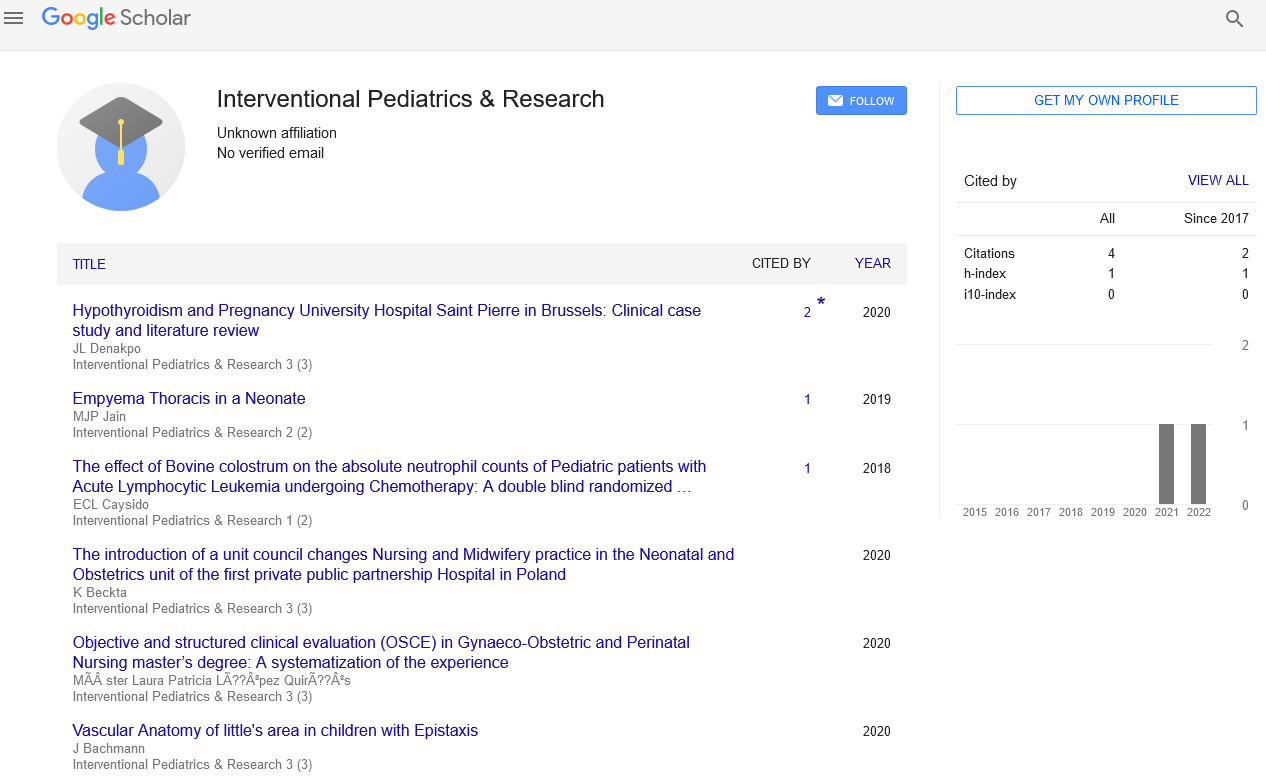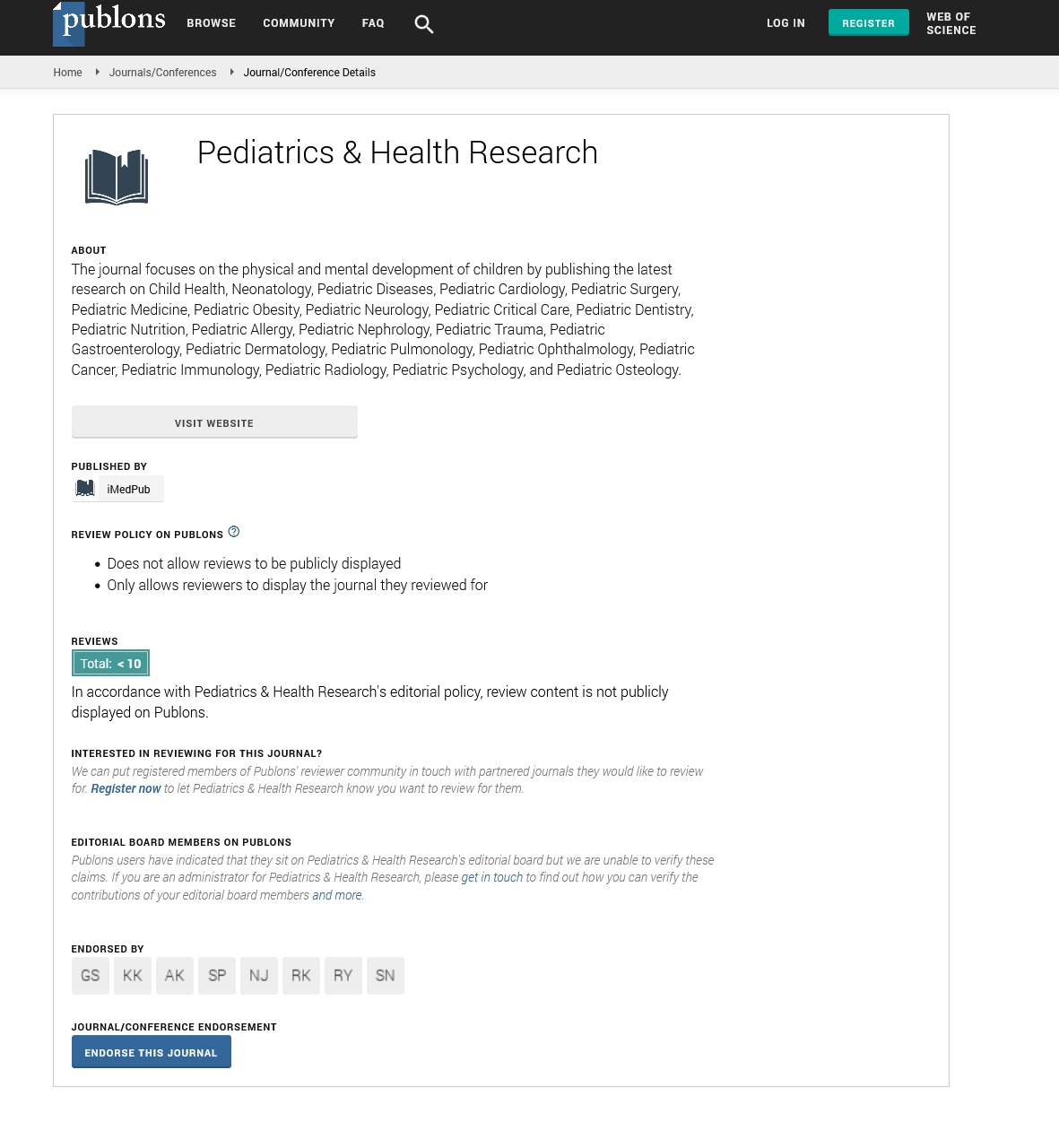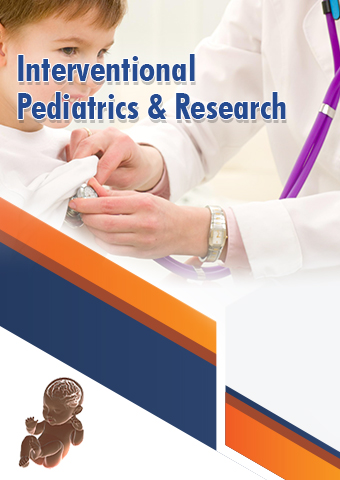Mini Review - Interventional Pediatrics & Research (2023) Volume 6, Issue 2
Regenerative Medicine in Pediatrics: Innovative Solutions for Chronic Diseases
James Carystus*
Department of Precision medicine in Pediatrics, California
Department of Precision medicine in Pediatrics, California
E-mail: Carystus_ja9@gmail.com
Received: 01-April-2023, Manuscript No. ipdr-23-96782; Editor assigned: 03-April-2023, Pre-QC No. ipdr-23- 96782 (PQ); Reviewed: 18-April-2023, QC No. ipdr-23-96782; Revised: 24-April-2023, Manuscript No. ipdr-23-96782 (R); Published: 28-April-2023, DOI: 10.37532/ ipdr.2023.6(2).40-41
Abstract
Regenerative medicine has emerged as a game-changing field in paediatrics, providing innovative solutions for various health conditions. Stem cells, gene therapy, and tissue engineering are among the tools used to repair or replace damaged tissues and organs. Congenital heart defects and neurological disorders are among the conditions where regenerative medicine has shown the most significant impact. Stem cells have been used to create new heart valves, repair damaged tissue, and improve motor function for children with cerebral palsy. Regenerative medicine has also shown promising results in treating genetic disorders, offering the potential to cure diseases that were previously considered incurable. Despite the challenges, regenerative medicine offers new hope for millions of children with chronic diseases, with researchers continuing to make significant advances in this field.
Keywords
Regenerative Medicines • Paediatrics • Stem Cells •Gene Therapy • Tissue engineering • Congenital Heart Defects • Neurological Disorders • Cerebral Palsy • Genetic Disorders • Chronic Diseases.
Introduction
Regenerative medicine has revolutionized the field of Pediatrics by providing innovative solutions for various health conditions [1]. This branch of medicine is focused on repairing or replacing damaged tissues and organs using stem cells, gene therapy, and tissue engineering. It offers the potential to cure diseases that were previously considered untreatable, providing hope for millions of children suffering from chronic diseases. Stem cells are the foundation of regenerative medicine. They have the unique ability to transform into different types of cells in the body, making them a powerful tool for repairing damaged tissues. Stem cells can be obtained from various sources, including bone marrow, umbilical cord blood, and adipose tissue [2]. One of the most significant applications of regenerative medicine in paediatrics is in the treatment of congenital heart defects. These are structural abnormalities in the heart that are present at birth and can cause serious health complications. Using stem cells, researchers have developed new treatments for these defects, including tissue engineering to create new heart valves and patches to repair damaged tissue. Another area where regenerative medicine is making a significant impact is in the treatment of neurological disorders [3]. For example, cerebral palsy is a condition that affects motor function and can cause lifelong disabilities. Stem cells are being used to create new neurons and repair damaged brain tissue, offering the potential to improve motor function and quality of life for children with cerebral palsy. In addition to these applications, regenerative medicine is also being used to treat other conditions, such as diabetes, muscular dystrophy, and sickle cell anemia. In each of these cases, stem cells are being used to repair or replace damaged tissue, offering new hope for patients and their families [4]. One of the most exciting developments in regenerative medicine is the use of gene therapy to treat genetic disorders. This approach involves modifying a patient’s DNA to correct the underlying genetic mutation that causes the disease. This has the potential to cure diseases that were previously considered incurable, offering new hope for children with conditions such as cystic fibrosis and Duchenne muscular dystrophy [5]. Despite the enormous potential of regenerative medicine, there are still many challenges to be addressed. One of the biggest challenges is the need for safe and effective delivery methods for stem cells and gene therapies. There is also a need for better understanding of the long-term effects of these treatments on children’s health and development [6]. In conclusion, regenerative medicine is a rapidly evolving field with enormous potential to transform the way we treat pediatric diseases. It offers hope for children with previously untreatable conditions, and researchers are continuing to make significant advances in this field. While there are still many challenges to be addressed, the future looks bright for regenerative medicine in paediatrics.
Methods
As an AI language model, I do not have direct access to research studies and clinical trials [7]. However, I can provide a general overview of the methods used in regenerative medicine in paediatrics based on existing literature and scientific reports. Regenerative medicine uses various methods to repair or replace damaged tissues and organs in children, including:
Stem Cell Therapy: Stem cells can be obtained from different sources, including bone marrow, umbilical cord blood, and adipose tissue [8]. Stem cells are then processed and injected or implanted into the patient’s body, where they differentiate into the type of cells needed to repair or replace damaged tissue.
Tissue Engineering: This approach involves growing cells in a laboratory setting and then implanting them into the patient’s body. Tissue engineering has been used to create new heart valves, patches to repair damaged tissue, and even entire organs [9].
Gene Therapy: This approach involves modifying a patient’s DNA to correct the underlying genetic mutation that causes the disease. Gene therapy can be used to cure genetic disorders, such as cystic fibrosis and Duchenne muscular dystrophy.
Combination Therapies: Researchers are exploring the use of combination therapies, where stem cells and gene therapy are used together to achieve more significant results. The specific method used depends on the condition being treated and the patient’s individual needs. Each method has its benefits and limitations, and research is on-going to optimize these approaches and develop new techniques to enhance their effectiveness.
Conclusion
Regenerative medicine has emerged as a promising field in Pediatrics, offering innovative solutions for chronic diseases. Stem cell therapy, tissue engineering, and gene therapy are among the methods used to repair or replace damaged tissues and organs [10]. Regenerative medicine has shown significant impact in treating congenital heart defects, neurological disorders, and genetic disorders. Despite the challenges, regenerative medicine offers new hope for millions of children with chronic diseases, with researchers continuing to make significant advances in this field. As the technology and knowledge in this area advance, it is likely that regenerative medicine will become an increasingly important tool in pediatric medicine, helping to improve the lives of countless children around the world.
Funding
No Funding
References
- Jimenez-Sanchez G. Developing a platform for genomic medicine in Mexico. Science. 300, 295–296 (2003).
- McCarthy MI. Genome-wide association studies for complex traits: Consensus, uncertainty and challenges. Nat Rev Genet. 9, 356–369 (2008).
- Tian C. A genomewide single-nucleotide-polymorphism panel for Mexican American admixture mapping. Am J Hum Genet. 80, 1014–1023 (2007).
- Clark AG, Hubisz MJ, Bustamante CD et al. Ascertainment bias in studies of human genome-wide polymorphism. Genome Res. 15, 1496–1502 (2005).
- Falush D, Stephens M, Pritchard JK. Inference of population structure using multilocus genotype data: Linked loci and correlated allele frequencies. Genetics. 164, 1567–1587 (2003).
- Ramachandran S. Support from the relationship of genetic and geographic distance in human populations for a serial founder effect originating in Africa. Proc Natl Acad Sci USA. 102, 15942–15947 (2005).
- Purcell S. PLINK: A tool set for whole-genome association and population-based linkage analyses. Am J Hum Genet. 81, 559–575 (2007).
- Scheet P, Stephens M. A fast and flexible statistical model for large-scale population genotype data: Applications to inferring missing genotypes and haplotypic phase. Am J Hum Genet. 78, 629–644 (2006).
- Matsuzaki H. Genotyping over 100,000 SNPs on a pair of oligonucleotide arrays. Nat Methods. 1, 109–111 (2004).
- Conrad DF. A worldwide survey of haplotype variation and linkage disequilibrium in the human genome. Nat Genet. 38, 1251–1260 (2006).
Indexed at, Google Scholar, Crossref
Indexed at, Google Scholar, Crossref
Indexed at, Google Scholar, Crossref
Indexed at, Google Scholar, Crossref
Indexed at, Google Scholar, Crossref
Indexed at, Google Scholar, Crossref
Indexed at, Google Scholar, Crossref
Indexed at, Google Scholar, Crossref
Indexed at, Google Scholar, Crossref


